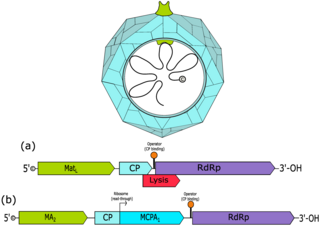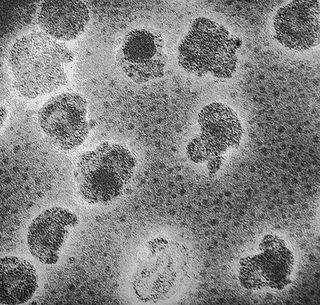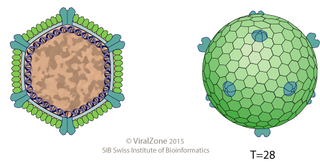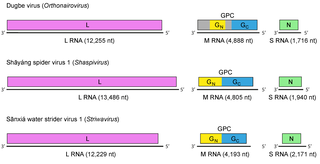| Adintoviridae | |
|---|---|
| Virus classification | |
| (unranked): | Virus |
| Realm: | Varidnaviria |
| Kingdom: | Bamfordvirae |
| Phylum: | Preplasmiviricota |
| Class: | Polintoviricetes |
| Order: | Orthopolintovirales |
| Family: | Adintoviridae |
| Genera and species | |
See text | |
| Adintoviridae | |
|---|---|
| Virus classification | |
| (unranked): | Virus |
| Realm: | Varidnaviria |
| Kingdom: | Bamfordvirae |
| Phylum: | Preplasmiviricota |
| Class: | Polintoviricetes |
| Order: | Orthopolintovirales |
| Family: | Adintoviridae |
| Genera and species | |
See text | |
The family contains the following two genera, which contain one species each: [1]

Totiviridae is a family of double-stranded RNA viruses. Giardia lamblia, leishmania, trichomonas vaginalis, and fungi serve as natural hosts. The name of the group derives from Latin toti which means undivided or whole. There are 28 species in this family, assigned to 5 genera.

Fiersviridae is a family of positive-strand RNA viruses which infect prokaryotes. Bacteria serve as the natural host. They are small viruses with linear, positive-sense, single-stranded RNA genomes that encode four proteins. All phages of this family require bacterial pili to attach to and infect cells. The family has 185 genera, most discovered by metagenomics. In 2020, the family was renamed from Leviviridae to its current name.

Arteriviridae is a family of enveloped, positive-strand RNA viruses in the order Nidovirales which infect vertebrates. Host organisms include equids, pigs, Possums, nonhuman primates, and rodents. The family includes, for example, equine arteritis virus in horses which causes mild-to-severe respiratory disease and reproductive failure, porcine reproductive and respiratory syndrome virus type 1 and type 2 in pigs which causes a similar disease, simian hemorrhagic fever virus which causes a highly lethal fever, lactate dehydrogenase–elevating virus which affects mice, and wobbly possum disease virus.

Plasmaviridae is a family of bacteria-infecting viruses. Acholeplasma species serve as natural hosts. There is one genus in the family, Plasmavirus, which contains one species: Acholeplasma virus L2. All viruses known in this family have been isolated from species in the class Mollicutes.

Globuloviridae is a family of hyperthermophilic archaeal viruses. Crenarchaea of the genera Pyrobaculum and Thermoproteus serve as natural hosts. There are four species in this family, assigned to a single genus, Alphaglobulovirus.

Bottigliavirus is the only genus in the family Ampullaviridae and contains 3 species. Ampullaviridae infect archaea of the genus Acidianus. The name of the family and genus is derived from the Latin word for bottle, ampulla, due to the virions having the shape of a bottle. The family was first described during an investigation of the microbial flora of hot springs in Italy.

Alphasphaerolipovirus is a genus of double stranded DNA viruses that infect haloarchaea. The genus contains four species.
Yingchengvirus is a genus of double stranded DNA viruses that infect haloarchaea. The genus was previously named Betasphaerolipovirus.
Hukuchivirus is a genus of double-stranded DNA viruses that infect thermophilic bacteria. The genus was previously named Gammasphaerolipovirus.
Turriviridae is a family of viruses; it contains only one genus, Alphaturrivirus. The archaea Sulfolobus solfataricus serve as natural hosts. There are two species in the genus Alphaturrivirus.
Permutotetraviridae is a family of viruses. Lepidopteran insects serve as natural hosts. The family contains one genus that has two species. Diseases associated with this family include: infection outcome varies from unapparent to lethal.

Nairoviridae is a family of viruses in the order Bunyavirales. Its name derives from Nairobi sheep disease, caused by the member Nairobi sheep disease orthonairovirus.
Jingchuvirales is an order of viruses.
Halopanivirales is an order of viruses.
Tectiliviricetes is a class of viruses.

Thaspiviridae is a family of incertae sedis spindle-shaped viruses. The family contains a single genus, Nitmarvirus, which contains a single species, Nitmarvirus NSV1.

Adnaviria is a realm of viruses that includes archaeal viruses that have a filamentous virion and a linear, double-stranded DNA genome. The genome exists in A-form (A-DNA) and encodes a dimeric major capsid protein (MCP) that contains the SIRV2 fold, a type of alpha-helix bundle containing four helices. The virion consists of the genome encased in capsid proteins to form a helical nucleoprotein complex. For some viruses, this helix is surrounded by a lipid membrane called an envelope. Some contain an additional protein layer between the nucleoprotein helix and the envelope. Complete virions are long and thin and may be flexible or a stiff like a rod.
Lefavirales is an order of viruses of the class Naldaviricetes. Viruses of this order have Hexapoda and Crustacea as their hosts, including Adoxophyes and Carcinus
Norzivirales is an order of viruses, which infect prokaryotes. Most of these bacteriophages were discovered by metagenomics.
Duinviridae is a family of RNA viruses, which infect prokaryotes.